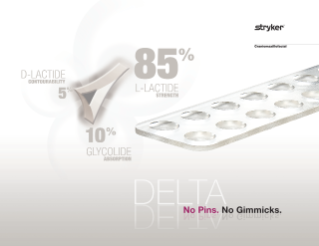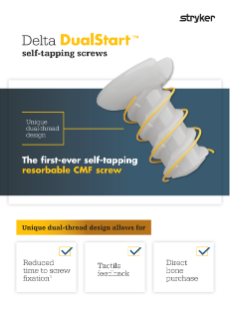Delta+
resorbable implant system

Delta DualStart Overview
Delta DualStart is the first-ever self-tapping resorbable CMF screw. The DualStart screw features a double-helix thread, and eliminates the need for a tap to be required.
Design modifications allow for:

*In comparison to previous process with standard screws.


Delta+ resorbable implant system overview:
Same polymer, new features
As you skillfully restore function and appearance for patients, Delta+ has an attractive combination of strength,1 balanced resorption2 and contourability1 for even your most complex procedures.
+ Strength retention
At 12 weeks and 6 months, Delta maintains 85% and 75% of its initial strength respectively,1 which can help facilitate structural fixation and reinforcement during osteosynthesis.
+ Resorption rate
Delta+ has a gradual resorption time, depending on the patient anatomy and metabolism, of approximately 8-13 months.2
+ Contourability
With the addition of 5% poly D-lactide, Delta plates and mesh are able to be shaped to fit your patients' anatomy.1







Clinical evidence
Abstract
An absorbable plating system is most commonly used to fix the bones in craniomaxillofacial surgery. Many studies focused on the advantages and clinical utility of absorbable plate and screws, but there are no reports on the complications related to these devices. From March 2004 to March 2009, 430 patients with facial bone fractures including infraorbital rim fractures underwent craniomaxillofacial surgery, in which rigid fixation was achieved with an absorbable plate and screws (Stryker, Freiburg, Germany). Five men with a delayed inflammatory reaction and infection at infraorbital rim fracture site were reviewed. Their mean age was 39 (range, 18-53 y), and all patients had maxillary sinusitis. The period from surgery to the onset of symptoms ranged from 3 to 10 weeks with a mean of 5 weeks. One patient was managed with oral antibiotics, but the other 4 patients required incisional drainage with the removal of the plate and screws because of abscess formation. The patients' symptom improved after removing the absorbable plate and screws and saline irrigation, and there was no recurrence of infection during the 12-month follow-up period. When fixing infraorbital fractures, particularly in patients with sinusitis, it is recommended to use short screws to prevent penetration of the maxillary sinus wall. In particular, one should pay attention and use shorter screws owing to the thinness of the medial infraorbital rim.
Abstract
Objective
The aim of this prospective study was to compare the clinical handling of 3 different biodegradable osteosynthesis materials and to determine whether they can be used for the fixation of all types of zygomatic fractures.
Study design
A total of 54 consecutive patients who presented with displaced fractures of the zygomatic bone between October 2001 and May 2003 were randomly allocated to 3 biodegradable material groups for the fixation of the fractures. A titanium fixation system was used as rescue osteosynthesis whenever biodegradable materials failed.
Results
Seventy-one (75.5%) of 94 fracture sites were fixed with biodegradable osteosynthesis; 23 (24.5%) had to be fixed with titanium plates and screws. No statistically significant difference was found between the 3 biodegradable materials with regard to their suitability for zygomatic fracture fixation (P = .16). Nonstable fixation (n = 7) or the need to fix small fragments (n = 16) were the reasons for using the titanium fixation system as rescue osteosynthesis at these sites. Biodegradable materials were most frequently unfeasible for use at the infraorbital rim and in the zygomaticomaxillary/anterior sinus wall area.
Conclusions
It was possible to stabilize 3 of 4 zygomatic fractures with 1.5- or 1.7-mm biodegradable osteosynthesis. Insufficient fracture stabilization, especially at the infraorbital rim and the zygomaticomaxillary crest/anterior sinus wall, was the main reason to switch to titanium osteosynthesis. The biodegradable screw design is possibly too bulky for these particular bony structures.
Abstract
There are distinct advantages and disadvantages between bioresorbable and permanent implants in orbital floor reconstruction. Our aim was to compare the outcomes and complications of resorbable implants and permanent implants in orbital floor fracture repair. A retrospective chart review was performed on all patients who underwent orbital floor fracture repair at a rural, tertiary care center from 2011 through 2016. Main outcome measures included improvement in diplopia, ocular motility, enophthalmos, hypoglobus, and infraorbital nerve sensation. A total of 87 patients underwent orbital floor reconstruction. After exclusion criteria were applied, 22 patients were included in the absorbable implant cohort, and 20 patients in the nonabsorbable implant cohort. All absorbable implants were composed of poly L-lactide/poly glycolide/poly D-lactide (PLL/PG/PDL), and nonabsorbable implants included both titanium/porous polyethylene (Ti/PPE) composite and titanium (Ti) mesh. Mean fracture surface area was 2.1 cm 2 (standard deviation [SD]: ± 0.9 cm 2 , range: 0.4–3.6 cm 2 ) for the absorbable implant group and 2.3 cm 2 (SD: ± 1.1 cm 2 , range: 0.6–4.4 cm 2 ) for the nonabsorbable implant group ( p = 0.58). There were no significant differences in diplopia, ocular motility, enophthalmos, hypoglobus, and infraorbital nerve sensation between absorbable and nonabsorbable implant groups. The mean follow-up time for absorbable and nonabsorbable implant groups was 622 (SD ± 313) and 578 (SD ± 151) days respectively ( p = 0.57). For moderate-size orbital floor fracture repairs, there is no difference in outcomes between absorbable implants consisting of PLL/PG/PDL and nonabsorbable implants consisting of Ti mesh or Ti/PPE combination.
Abstract
Biodegradable plates have been used extensively in fracture fixation since the 1960s. They rarely cause stress-protection atrophy or problems requiring secondary plate removal, common complications seen with metallic plates. However, aseptic foreign-body reactions have been reported, sometimes years after the original implantation. Both inadequate polymer degradation and debris accumulation have been implicated as causes. The current generation of commercial biodegradable plates is formulated to minimize this complication by altering the ratio of polylactic and polyglycolic acids. This in vivo study compares the degree of local foreign-body reaction of two commercially available resorbable plates in rabbits. Two types of biodegradable plates were examined: poly(D/L)lactide acid (PDLLA) and polylactide-co-glycolide acid (PLGA). Each plate was placed into a periosteal pericalvarial pocket created beneath the anterior or posterior scalp of a rabbit. Humane killing occurred at 3, 6, and 12 months postoperatively. Foreign-body reaction was evaluated histologically. The PDLLA plates demonstrated marked local foreign-body reactions within the implant capsule as early as 3 months after implantation, with presence of inflammatory cells and granulomatous giant cells in close association with the implant material. All local foreign-body reactions were subclinical with no corresponding tissue swelling requiring drainage. PLGA plates did not demonstrate any signs of inflammatory reactions. In addition, the PLGA plates did not appear to resorb or integrate at 12 months. Neither PDLLA nor PLGA plates demonstrated inflammation of the soft tissue or adjacent bone outside the implant capsule. In our study, the PDLLA plates demonstrated histological evidence of foreign-body reaction that is confined within the implant capsule, which was not seen with the PLGA plates. This finding may be attributable to the lack of significant resorption seen in the PLGA plates. Both PDLLA and PLGA plates were biocompatible with the rabbit tissue environment and should be considered for continued use in craniofacial, maxillofacial, and orthopedic reconstruction.
Abstract
Introduction
Several bioresorbable plating systems have become standard in pediatric craniosynostosis reconstruction. A comparison of these systems is needed to aid surgeons in the preoperative planning process. The authors aim to evaluate 1 institution's experience using Resorb-X by KLS Martin and Delta Resorbable Fixation System by Stryker (Stryker Craniomaxillofacial, Kalamazoo, MI).
Methods
A sample of patients with single-suture nonsyndromic craniosynostosis treated at St Louis Children's Hospital between 2007 and 2014 using either Resorb-X or Delta bioresorbable plating systems were reviewed. Only patients with preoperative, immediate, and long-term 3-dimensional photographic images or computed tomography scans were included. A comparison of plating system outcomes was performed to determine the need for clinic and emergency room visits, imaging obtained, and incidence of subsequent surgical procedures due to complications.
Results
Forty-six patients (24 Resorb-X and 22 Delta) underwent open repair with bioabsorbable plating for single suture craniosynostosis. The mean age at each imaging time point was similar between the 2 plating systems (P > 0.717). Deformity-specific measures for sagittal (cranial index), metopic (interfrontotemporale), and unicoronal (frontal asymmetry) synostosis were equivalent between the systems at all time points (0.05 < P < 0.904). A single Delta patient developed bilateral scalp cellulitis and abscesses and subsequently required operative intervention and antibiotics.
Conclusions
Bioabsorbable plating for craniosynostosis in children is effective and has low morbidity. In our experience, the authors did not find a difference between the outcomes and safety profiles between Resorb-X and Delta
CMF-WC-57_Rev. None_18996
Resources
Related products
Universal Select
Universal Select is the latest in a generation of Craniomaxillofacial fixation systems, featuring a wide selection of high quality implants for bone fixation of Craniomaxillofacial fractures, orthognathic and reconstructive surgery.
Learn moreVariSpeed battery powered screwdriver
Designed for drilling pilot holes and placing screws.
Learn moreVSP® Cranial
A digital planning solution for your cranial vault reconstruction procedures.
Learn moreRequest information
References:
- Stryker R&D report, report no. RD-98-004.
- Ricalde, P. & Posnick, J. C. (2004). Degradation rate of delta (resorbable) internal fixation: report of 2 cases. JOral Maxillofac Surg, 62(2), 250-255.
CMF-DELT-SYK-1986322_REV-0








